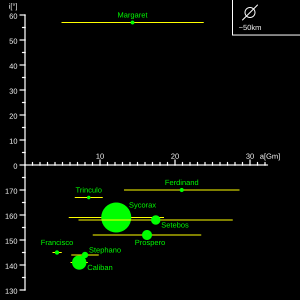Margaret (księżyc)
| ||
 | ||
| Planeta | Uran | |
| Odkrywca | Scott Sheppard, David Jewitt | |
| Data odkrycia | 29 sierpnia 2003 | |
| Tymczasowe oznaczenie | S/2003 U3 | |
| Charakterystyka orbity | ||
| Półoś wielka | 14 146 700 km[1] | |
| Mimośród | 0,6772[1] | |
| Okres obiegu | 1661,00 d[1] | |
| Nachylenie do ekliptyki | 57,367°[1] | |
| Długość węzła wstępującego | 7,067°[1] | |
| Argument perycentrum | 90,017°[1] | |
| Anomalia średnia | 322,187°[1] | |
| Własności fizyczne | ||
| Średnica równikowa | ~20 km | |
| Średnia gęstość | 1,3 g/cm³ | |
| Albedo | 0,04 | |
| Jasność obserwowana (z Ziemi) | 25,2m | |
Margaret (Uran XXIII) – mały, zewnętrzny księżyc Urana, odkryty przez Scotta S. Shepparda i in. w 2003 roku.
Nazwa księżyca pochodzi od imienia służącej z komedii Williama Szekspira pt. Wiele hałasu o nic. Wcześniej nosił on tymczasową nazwę S/2003 U3[2].
Orbita
Półoś wielka orbity tego księżyca wynosi 14,1 mln km, a jeden obieg wokół Urana zajmuje mu około 4,5 roku.
Margaret wyróżnia się spośród pozostałych księżyców nieregularnych Urana tym, że porusza się po swojej wydłużonej orbicie ruchem prostym (zgodnie z kierunkiem obrotu planety), podczas gdy wszystkie księżyce grupy Sykoraks poruszają się ruchem wstecznym, a ich odchylenie od ekliptyki wynosi 140°–170°.
Inklinacja orbity Margaret jest bliska granicy stabilności ze względu na efekt Kozai. Efekt ten sprawia, że nie są znane żadne księżyce o orbitach nachylonych pod kątami pomiędzy 60° a 140° – po odpowiednio długim czasie księżyc na takiej orbicie rozbije się o powierzchnię planety lub zostanie wyrzucony z układu.
Zobacz też
Przypisy
Media użyte na tej stronie
Discovery images of one of the newly found Uranus satellites S/2003 U3 (Margaret) showing its motion relative to background stars and galaxies.
This is a revised version of Solar_System_XXIX.png.
This image of Uranus was compiled from images returned Jan. 17, 1986, by the narrow-angle camera of Voyager 2. The spacecraft was 9.1 million kilometers (5.7 million miles) from the planet, several days from closest approach. This picture has been processed to show Uranus as human eyes would see it from the vantage point of the spacecraft. The picture is a composite of images taken through blue, green and orange filters. The darker shadings at the upper right of the disk correspond to the day-night boundary on the planet. Beyond this boundary lies the hidden northern hemisphere of Uranus, which currently remains in total darkness as the planet rotates. The blue-green color results from the absorption of red light by methane gas in Uranus' deep, cold and remarkably clear atmosphere.
Autor: User:Eurocommuter, Licencja: CC-BY-SA-3.0
Irregular satellites of Neptune. Plotted by a program written by Eurocommuter.
The position of a satellite represents
- its orbit’s semi-major axis a in Gm (horizontal axis)
- orbit’s inclination i in degrees (vertical axis).
- the size of the circle illustrates the satellites's size relative to others:
The eccentricity of the orbit is shown indirectly by a segment extending from the left (pericenter) to the apocentre to the right. In other words, the segment illustrates the variations of the object's distance from the planet.
Satellites beneath the axis (i>90) are retrograde.




